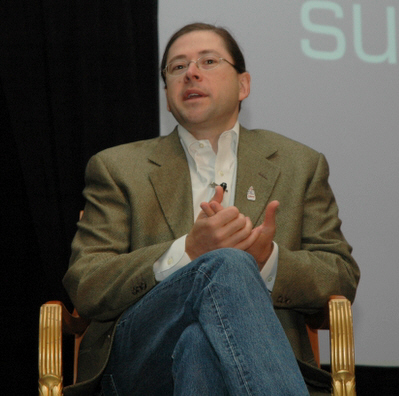Supernova: Jonathan Schwartz chasing workloads

"All client devices will be functionally identical in three to five years. The applications and services will be identical. You will be able to watch the World Cup on any device. We'll rely on the uniformity to focus on infrastructure that is agnostic to devices, creating the broadest market possible for datacenters." That's how Sun CEO Jonathan Schwartz views the world and Sun's opportunity--chasing the large scale, horizontal workloads, which are growing at a faster rate than Moore's Law.

Schwartz made the remarks during an interview with Kevin Werbach at Supernova 2006 this morning. He emphasized Sun's R&D focus ($2 billion this year) as a differentiator. As an example of flexing his R&D muscle, Schwartz said his whole company can run on $50,000 to $100,000 worth of Sun T2000 servers. "For scale and efficiency of infrastructure, we are well positioned to deliver it," Schwartz said. "One hundred percent of companies are looking to IT as they looked to electricity a hundred years ago"
Schwartz lamented that with 17,000 Sun people in the field, he feels like a small company compared to IBM or HP. A hundred percent of companies want to talk to someone. "We have to make choices about who to call on. If you try to solve all problems in the marketplace, you will drown," Schwartz said. In a broad stroke, he reprised his notion that demand for Internet services will continue to grow and that Sun needs to intercept a good share of that demand. "If you are not in front of the next wave of consumer demand, you will miss out on the market," he said.
In terms of who to call on and what to focus the R&D spend on, Schwartz said that datacenter innovations, such as security and provisioning improvements, and driving standards are key for Sun, not building consumer devices or services. In fact, Sun wants to provide the infrastructure that allows consumer services and devices to interact on the network and receive executable content.
Schwartz said the company has undergone a review with 11,000 engineers at Sun to figure out the projects that should make the cut. One finding is that the era of custom hardware is on its way out, Schwartz said, stating the obvious. He pointed to Sun's Thumper project, a SunFire server with 24 terabytes of storage and a software-based RAID controller, which can run applications directly on the storage device, as an example of Sun's home grown innovation.
In addition, Schwartz said he is focused on reaching the developer community, which requires a different approach than reaching CIOs. "CIOs are making fewer decisions as each day passes. Developers don't read the Wall Street Journal or New York Times," Schwartz said. "They are on the Web, and that's where I want to be. These are the constituents that can transform our business, and blogs are a mechanism to reach them." Schwartz uses his own blog to send his message out and get in front of the marketplace.
Werbach asked Schwartz what he would do if he were starting a company today. "We are in the business of ten things that cost a million bucks, sometimes I wish I were selling a million things worth ten bucks," he said.
Prior to the panel I asked him about the pink slips that we had reported would be issued today as part of the layoffs announced May 31. Some Sun employees in the San Francisco Bay area and in other locations will get news of their fate today, but the company won’t be making any press announcements related to layoffs. “It’s part of an ongoing process that started on May 31,” he said.